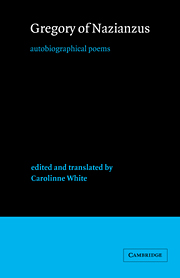Introduction
Published online by Cambridge University Press: 24 August 2009
Summary
Gregory of Nazianzus: a biographical outline
Gregory of Nazianzus was one of the three leading orthodox Christians in the Greek church of the fourth century: like his friend Basil of Caesarea and Basil's brother Gregory of Nyssa, Gregory was a native of Cappadocia, in what is now eastern Turkey, and the three of them are therefore often referred to as the Cappadocian Fathers. Gregory of Nazianzus himself is also known as Gregory the Theologian in the Eastern church, largely on the strength of the five theological orations which he gave in Constantinople and which stand out among his forty-four extant orations for their detailed and precise discussion, based on principles laid down at the Council of Nicaea in 325, of Trinitarian doctrine — of the relationship between Father, Son and Holy Spirit. The importance of his orations is shown by the fact that during the Middle Ages they were translated into Latin, Syriac, Coptic, Georgian, Armenian, Slavonic and Arabic. Gregory enjoyed high prestige because of his outstanding rhetorical talents: he and John Chrysostom are generally considered the greatest Christian orators in the late antique Greek world and Gregory has been referred to as the Christian Demosthenes. His virtue in this field lay in his ability to communicate clearly, relying more on evocative images than on dialectic.
- Type
- Chapter
- Information
- Gregory of NazianzusAutobiographical Poems, pp. xi - xxxPublisher: Cambridge University PressPrint publication year: 1996

